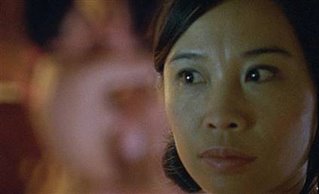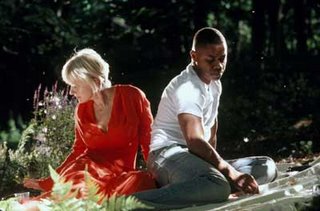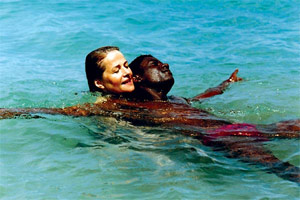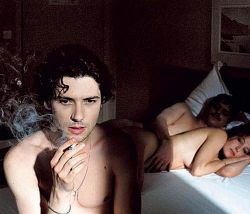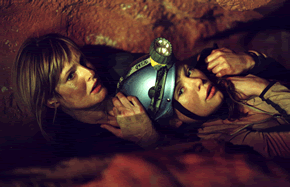Kylie Minogue and Aural Transvestitism
 I use an iPod on a daily basis. Mine is one of the early video incarnations of the device, though I have yet to purchase any features or music videos, even. With the exception of the video pieces of mine which I have uploaded onto the device, the only visuals it ever displays are the album covers for the tracks which it currently plays.
I use an iPod on a daily basis. Mine is one of the early video incarnations of the device, though I have yet to purchase any features or music videos, even. With the exception of the video pieces of mine which I have uploaded onto the device, the only visuals it ever displays are the album covers for the tracks which it currently plays.
In my day to day, I ride the subway to work, music, all the while, plays in my ears. There’s a peculiar tendency which I have noticed when, above ground – and without the scrutiny of my fellow subway passengers – I begin to imitate the gestures of the song to which I am listening. This behavior has been most notable in my recent and exhaustive listening to Kylie Minogue. Not that this phenomenon is in any way isolated to the Aussie Pop songstress. I imagine it could be claimed for Pop music, at large – or vocally based music, period, with its infectious identification. Yet Pop is the avenue which most prolifically perpetuates the visual cues to its aural basis. The formulaically mechanical and glistening sheen of the Pop video, in a great many ways mirrors my iPod. Sleek, shiny, minimal – the sound, unbearable by technical standards (a step back in our step forward?) much like Pop’s role as lesser genre when approached critically. It does, however, yield the greatest revenue in the industry. My tastes tend to steer rather clear of most Pop top 40 sensations – not that I think ill of them – and writing this article here, in the United States, alienates the greater mainstream associations to Kylie who is still, surprisingly, not a household name. Across the oceans, a gaggle of other countries feel very differently about Minogue; there, she is a force to be reckoned with. She’s certainly been on my mind lately – probably more than any healthy person would care to admit to.
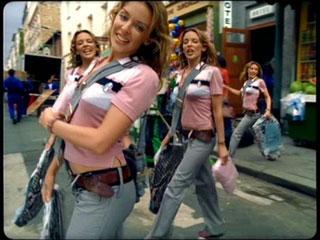 I’ve watched all of the DVDs – and there are many: Live In Sydney, Live In Manchester, Live at the Apollo in London, Ultimate Kylie: The Videos… All of this supplies me with a vast visual repertoire to associatively marry to the music. So, when I hear the single, “Come Into My World,” not only do I conjure Michel Gondry’s lovely video that finds Kylie circling the same few city blocks, perpetually stumbling upon a multitude of other selves, who all seems to absent-mindedly drop their purses as they exit the dry cleaners (but, don’t worry, prior Kylie always retrieves the former’s goods), I also see RoboKylie being brought to life upon the stage of her 2002 Fever tour and the Showgirl Tour's torch song Kylie, taking it down a notch, while the glittering crescent moon on which she’s perched is lifted “up, up, high up on your love.”
I’ve watched all of the DVDs – and there are many: Live In Sydney, Live In Manchester, Live at the Apollo in London, Ultimate Kylie: The Videos… All of this supplies me with a vast visual repertoire to associatively marry to the music. So, when I hear the single, “Come Into My World,” not only do I conjure Michel Gondry’s lovely video that finds Kylie circling the same few city blocks, perpetually stumbling upon a multitude of other selves, who all seems to absent-mindedly drop their purses as they exit the dry cleaners (but, don’t worry, prior Kylie always retrieves the former’s goods), I also see RoboKylie being brought to life upon the stage of her 2002 Fever tour and the Showgirl Tour's torch song Kylie, taking it down a notch, while the glittering crescent moon on which she’s perched is lifted “up, up, high up on your love.”
I see these images in my mind, replay them to their audio counterparts. Sound and image are inextricably wed – so much so that a particular enigma occurs when I walk down the street, music thumping. So steeped am I in the tracks visual cues, and so interior is the act of listening to the iPod’s closed circuit sphere (or, literally, pod) of a headphone inserted in each ear, that, in effect, the video becomes the basis for the stage onto which I cast myself. The iPod’s implied pod (that interior which separates myself from the world around me) sets the aural scene and my visual world, unmediated/unproduced, reels in competition. ‘Where,’ my eyes wonder, ‘are my robotic dancers to exorcise these beats?’ This music floods my mind, becomes my thoughts – for don’t thoughts occupy that same bit of matter which is trapped between each headphone, blare with the same interiority as that music? If it rests in that same space as my thoughts, am I not correctly mistaking these songs as my own, of my own imagining? I, in a sense, authorize this music. So misguided, my ears fulfilled, were we to follow this thought to its logical end, I engage in a covert form of transvestitism. I, for the tracks’ duration, allow myself to become Kylie Minogue. With the knowledge of the videos' gestures – but stronger still, with their burning absence – I assume their step. I throw my hip like the white-clad Kylie in the “Can’t Get You Out of My Head” promo. I pale in comparison, of course, but the potency of this performance is most critical in its outward view from within.
It is a similar concept to the bedroom-singing-into-the-hairbrush paradigm, though the inner sanctum of the bedroom has been further inverted to within the body itself (to the furthest possible interior) while the concrete locale has become public. Interestingly, the private becomes (literally) the interior of the self. What’s more, the ubiquitous threat of discovery (the daring and nervy end of the performance – the sanctum being violated and you, caught mid note) and the humiliation which results of this impersonation are so totally magnified because of their publicity. Humiliation is almost assured as your location drifts from private to public. Interior conflict becomes: to perform (yield to your performative desires) or conform (to public, read social, codes of conduct).
 Is walking down the street, traipsing as Kylie, then, a socially rebellious gesture? On the one hand, this enigma could be viewed as the digital ideal of those ladies documented in Jennifer Livingston’s film Paris Is Burning. “Passing,” there, meant a gender transformation so complete and undetected of its malleability, that they fit in to the world at large. Livingston’s ladies were part of the scene at the Harlem Drag balls. The Drag ball, which is foremost a theatrical world, reached its apex when the voguer would be indiscernible as the opposite gender from which they performed. Here, we are presented with an anomaly where the masquerade as opposite gender may be interiorized – met aurally – unfettered by the need for physical transformation. One may "pass" on the street as male, yet because of this aural interiority, the assumption of the opposite sex is covertly enacted. (Of course, this is as it pertains to drag’s theatrical desires. The shift from male to female for people of the transgender community is a far more complicated one – one which cannot be exacted through a mere iPod!)
Is walking down the street, traipsing as Kylie, then, a socially rebellious gesture? On the one hand, this enigma could be viewed as the digital ideal of those ladies documented in Jennifer Livingston’s film Paris Is Burning. “Passing,” there, meant a gender transformation so complete and undetected of its malleability, that they fit in to the world at large. Livingston’s ladies were part of the scene at the Harlem Drag balls. The Drag ball, which is foremost a theatrical world, reached its apex when the voguer would be indiscernible as the opposite gender from which they performed. Here, we are presented with an anomaly where the masquerade as opposite gender may be interiorized – met aurally – unfettered by the need for physical transformation. One may "pass" on the street as male, yet because of this aural interiority, the assumption of the opposite sex is covertly enacted. (Of course, this is as it pertains to drag’s theatrical desires. The shift from male to female for people of the transgender community is a far more complicated one – one which cannot be exacted through a mere iPod!)
Being Kylie could be too specific. So rooted is my metamorphosis in a(nother’s) projected (and mediated) image of “self.” And I do not, for a moment, think Kylie to be an actual person – at least, not the Kylie I know. There are far too many factors determining her for there to truly be a her. She is a role. For an apt analogy, she is a costume to be donned and discarded (by the “real” Kylie, or from my outward vantage, by myself). I am, in truth, being fed a very traditional, one might even venture to argue misogynistic, icon of femininity. Girl next door and sex pot are not the most progressive roles for a woman (or myself) to embody. But drag has always found its purpose in both extremes and the exaggeration of stereotypes. The ladies of Paris Is Burning are almost absurdly feminine.
And, ultimately, the headphones are removed from my ears, the player is paused, the spell is broken. The traipse is an escape and the world still goes on around us. However brashly one might criticize escapism, though, the politically charged gender play is, at least at some level, insurmountable. It’s there, and certainly a determining factor in contemporary pop music. I’m glad I don’t have videos on my iPod. If I did, I would only be able to watch little digital Kylie walk in her circles. For these short moments, I would not be able to come into her world.




